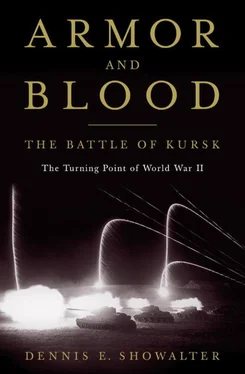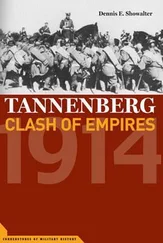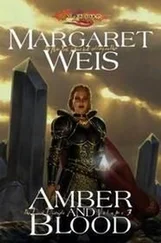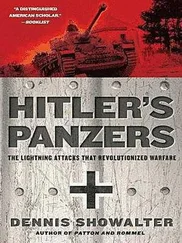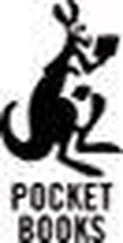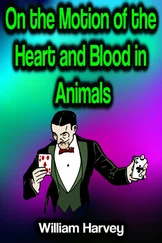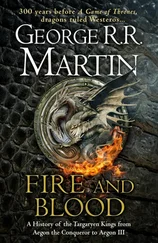66 As of 10:45 P.M.Totenkopf’s report of 22.45 in Stadler, Offensive gegen Kursk , p. 105; Nipe, Blood, Steel, and Myth , pp. 349–350.
67 Spent time in a mental hospitalCharles W. Sydnor, Jr., Soldiers of Destruction: The SS Death’s Head Division, 1933–1945 (Princeton, NJ: Princeton University Press, 1977), p. 8.
68 The original, Soviet versionZamulin, Demolishing the Myth , pp. 516–543, covers Russian mythology; Frieser et al., Ostfront , pp. 129–135, is the German counterpoint. Nipe, Blood, Steel, and Myth , pp. 326–327, focuses on the number of tanks directly involved.
69 Noted only one for July 12Ralf Tiemann, Chronicle of the 7. Panzer-Kompanie I. SS-Panzer Division “Leibstandarte,” trans. Allen Brandt (Atglen, PA: Schiffer Publishing, 2004), p. 60.
70 Demanding to know what had happenedGlantz and House, Battle of Kursk , p. 428, fn. 31; Frieser et al., Ostfront , pp. 132–133; Zamulin, Demolishing the Myth , pp. 441, 507.
71 Rotmistrov shaking from the stressArmstrong, Red Army Tank Commanders , pp. 320–322. In the course of World War II, over 250 Russian generals were executed or sent to penal units. Christopher N. Donnelly, “The Soviet Attitude Toward Stress in Battle,” in Contemporary Studies in Combat Psychiatry , ed. Gregory Belenky (Westport, CT: Greenwood Press, 1987), p. 233.
72 Stalin remained sufficiently disturbedZamulin, Demolishing the Myth , p. 457; Zhukov, Reminiscences and Reflections , p. 190.
73 Manstein “thanked and praised”“Generalkommando II. SS. Pz.-Korps, 22.00 Uhr.,” in Stadler, Offensive gegen Kursk , p. 104.
74 Hoth was edgy“KTB 4th Panzerarmee, Chefnotizen für 21.7.1943,” National Archives, T-314, roll 1170.
75 “Nothing mattered to me any more”Lochmann et al., Tiger Tank Battalion 503 , pp. 116–117. Nipe, Blood, Steel, and Myth , p. 363, summarizes the state of the SS; conditions were no better in the army formations.
76 Ideological racism and cultural arroganceCf. Neitzel and Welzer, Soldaten , p. 317–343.
77 Delivered by phoneStadler, Offensive gegen Kursk , p. 103.
78 Solid prospects existed for a breakthroughGlantz and House, Battle of Kursk , p. 209, speak of “cautious optimism.” Nipe, Blood, Steel, and Myth , p. 353, stresses the shock effects of July 12 on Hoth and his staff.
79 Hoth’s final orders arrived“Durch FS um 20.45 Uhr.: An II-SS Pz.-Korps,” in Stadler, Offensivegegen Kursk , p. 103.
80 Corps intelligence summary“Feindlage 12.7.1943, Stand: 21.00 Uhr.,” in ibid., pp. 105–106.
81 Hausser responded to Hoth“Auftraege für 13.7.43” (the “14” in the text is an obvious misprint), in ibid., p. 105; “KTB II. SS-Panzerkorps an SS Divisionen ‘LSAH,’ ‘DR,’ und ‘T’ … Auftraege für 13.7.43,” National Archives, T-354, roll 605.
1 The Russians came to itCf. Harrison, Russian Way of War , and the more comprehensive overview by Jacob Kipp, “The Tsarist and Soviet Operational Art, 1853–1991,” in Evolution of Operational Art , pp. 64–95.
2 Its rebirth was a two-year process“Rebirth” is the central theme of Glantz, Stumbling Colossus .
3 Preparations for KutuzovGlantz and House, Battle of Kursk , pp. 227–232; and Glantz, “Soviet Military Strategy,” Journal of Military History 60, no 1 (1996).
4 An inactive sectorThat description is relative. See Franz Kurowski, Deadlock Before Moscow: Army Group Center, 1942/1942 , trans. Joseph G. Welsh (Atglen, PA: Schiffer Publishing, 1992).
5 Locus of a serious plotPeter Hoffmann, “Trecksow and Army Group Center,” in The History of the German Resistance, 1933–1945 , trans. Richard Barry (Cambridge, MA: MIT Press, 1977), pp. 264–289.
6 Confronted Operation KutuzovFor the final balance of forces, see Frieser et al., Ostfront , pp. 98–99.
7 Achieved almost complete surpriseDavid M. Glantz, Soviet Military Deception in the Second World War (London: Routledge, 1989), pp. 160–193.
8 Launch time was determinedFor a general operational overview, see John Erickson, The Road to Berlin: Continuing the History of Stalin’s War with Germany (Boulder, CO: Westview Press, 1983), p. 108. Major General Peter von der Groeben, “Ninth Army and Second Panzer Army,” in Kursk: The German View , pp. 108–112, gives a German staff officer’s perspective.
9 Airpower played a major roleBergström, Kursk: The Air Battle , pp. 82–84; Hardesty and Grinberg, Red Phoenix Rising , pp. 261–265.
10 Had his ups and downsGeoffrey Jukes, “Bagramyan,” in Harold Shukman, ed., Stalin’s Generals , pp. 26–27.
11 Bryansk Front found the going tougherLothar Rendulic, “Die Schlacht von Orel, Juli 1943: Wahl und Bildung des Schwerpunktes,” Österreichische Militärische Zeitschrift 1 (1963): 130–138.
12 Owed a good part of their successBergström, Kursk: The Air Battle , pp. 85–86.
13 A rapidity … Newton, calls suspiciousNewton, Hitler’s Commander , pp. 253–255.
14 The 12th Panzer had spent a weekThe division’s records are summarized in Antonius John, Kursk ’43: Szenen einer Entscheidungsschlacht (Bonn: H&H Konzept Verlag, 1993), pp. 106–118.
15 “The threshold to battle hell”Ibid., pp. 117, 120. The 5th Panzer Grenadier Regiment was part of 12th Panzer Division.
16 In a strategic … cleft stickSimon Ball, The Bitter Sea: The Struggle for Mastery in the Mediterranean, 1935–1949 (London: HarperPress, 2010), and Douglas Porch, The Path to Victory: The Mediterranean Theater in World War II (New York: Farrar, Straus & Giroux, 2004), are the best overviews from, respectively, a policy/strategy and a strategic/operational perspective. Citino, The Wehrmacht Retreats , brilliantly integrates the synergies of the Mediterranean theater and the Russian front.
17 Italy was a broken reedMacGregor Knox, Hitler’s Italian Allies: Royal Armed Forces, Fascist Regime, and the War of 1940–1943 (New York: Cambridge University Press, 2000), is an analytical overview. Gerhard Schreiber, “Das Ende des nordafrikanischen Feldzugs und der Krieg in Italien 1943 bis 1945,” in Frieser et al., Ostfront , pp. 1100–1114, summarizes the German perspective of the Axis endgame.
18 But where?Citino, The Wehrmacht Retreats , pp. 172–175, presents the options.
19 His reputation for optimismAlbert Kesselring, Kesselring: A Soldier’s Record , trans. Lynton Hudson (New York: William Morrow, 1954), pp. 196–198; Schreiber, “Ende des nordafrikanischen Feldzugs,” in Frieser et al., Ostfront , p. 1113.
20 Hitler should have come forwardManstein, Verlorene Siege , p. 501.
21 “Under the sun-ray lamp”Stahlberg, Bounden Duty , p. 307.
22 Hitler’s presentationManstein, Verlorene Siege , pp. 501–503; Frieser et al., Ostfront , pp. 141–142.
Читать дальше
